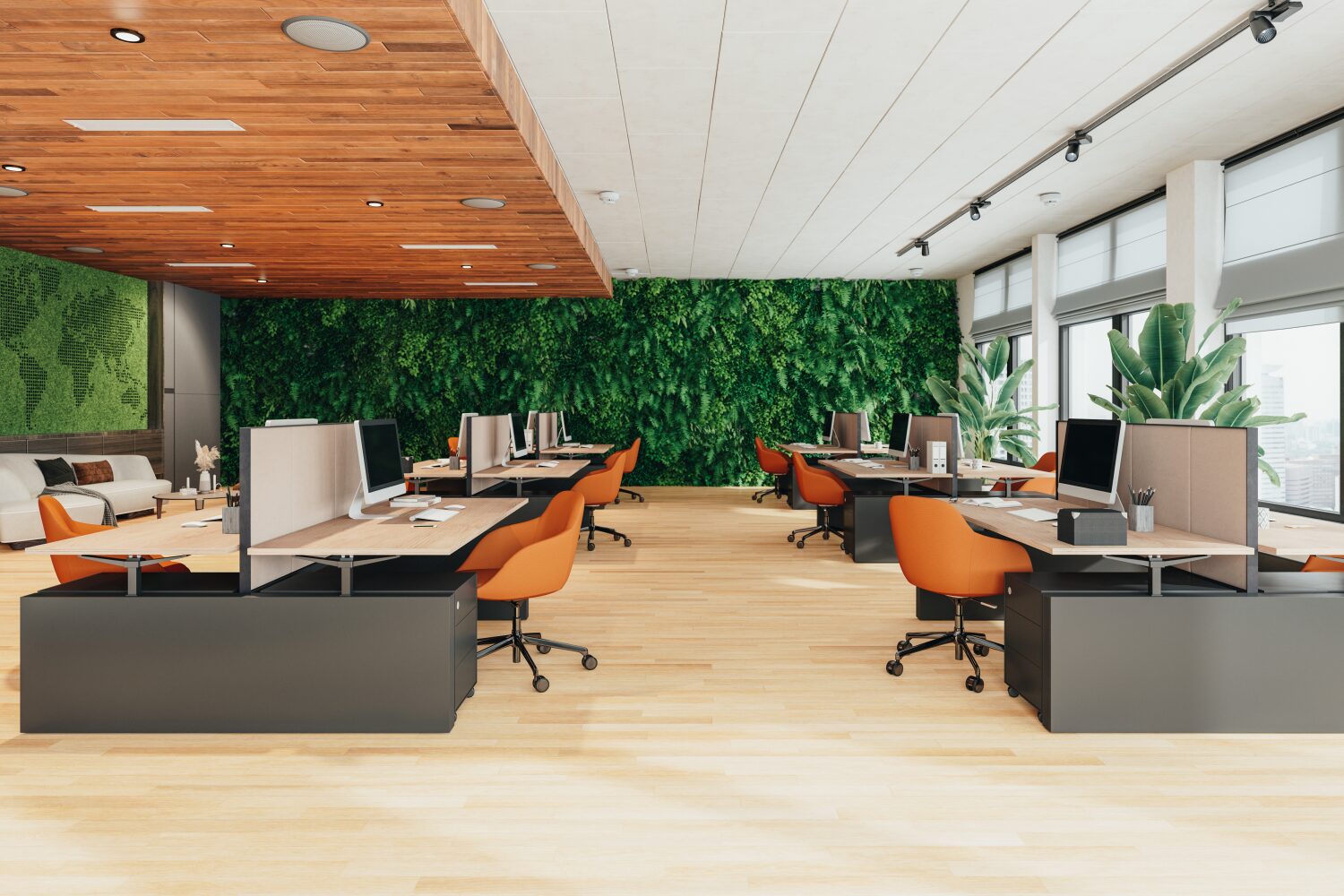In today’s fast-evolving workplaces, the focus has shifted beyond just aesthetics and functionality. Organizations are now placing greater emphasis on sustainability, wellness, and long-term performance. One of the most underappreciated yet highly impactful ways to promote both employee well-being and productivity is by integrating eco friendly office furniture into your workspace design.
When your furniture supports physical comfort, mental clarity, and environmental consciousness all at once, you’re building a healthier, more productive environment for everyone.
Why Wellness Matters in Office Design
Wellness in the workplace isn’t a luxury anymore—it’s essential. Chronic stress, poor posture, eyestrain, and respiratory issues have all been linked to poorly designed office environments. This is where thoughtful, health-oriented choices like ergonomic seating, clean air materials, and biophilic design come into play.
Benefits of Prioritizing Wellness at Work:
-
Reduced absenteeism and health-related costs
-
Increased focus, attention, and mental clarity
-
Greater employee satisfaction and retention
-
Enhanced workplace morale and collaboration
What Makes Furniture Eco-Friendly and Wellness-Oriented?
Eco friendly office furniture isn’t just about being “green.” It combines sustainable sourcing with human-centered design. Here are the core features:
-
Non-toxic materials: Free of VOCs, formaldehyde, and harmful glues
-
Sustainable sources: FSC-certified wood, recycled metal or plastic, and organic textiles
-
Ergonomic structure: Designed to support natural posture and body movement
-
Biophilic elements: Natural textures and finishes that connect employees to nature
-
Longevity and durability: Reduces landfill waste and constant replacement cycles
5 Ways Eco Friendly Office Furniture Supports Employee Wellness
1. Improves Indoor Air Quality
Standard office furniture often releases toxic gases from synthetic finishes, foams, and glues. These VOCs (volatile organic compounds) can lead to headaches, fatigue, and long-term health issues.
Eco-friendly options use:
-
Water-based adhesives
-
Low-VOC finishes
-
Natural latex or organic foam
Better air quality means better focus, energy, and well-being throughout the day.
2. Encourages Movement and Good Posture
Ergonomics is at the heart of both comfort and long-term health. Chairs with lumbar support, height-adjustable desks, and footrests made from eco-conscious materials encourage natural movement and reduce musculoskeletal strain.
Using eco friendly office furniture designed with ergonomics in mind ensures physical comfort while minimizing your environmental footprint.
3. Reduces Noise for Better Focus
Sustainable acoustic panels made from recycled PET bottles, cork, or felt help dampen sound in open-plan offices. These materials improve concentration and reduce stress caused by auditory distractions.
When combined with natural elements like bamboo dividers or wooden wall cladding, they create a calming, quiet workspace.
4. Connects People with Nature
Studies show that access to nature—or even just nature-inspired design—can reduce cortisol levels and improve mood. Natural materials like wood, wool, and linen add warmth, while indoor planters and green walls encourage relaxation.
Many eco friendly office furniture pieces incorporate biophilic design elements, creating a workspace that nurtures mental well-being.
5. Supports Mental Clarity and Visual Balance
Furniture that uses calming color palettes, clean lines, and textures inspired by the natural world promotes mental clarity. Uncluttered layouts and natural lighting further reduce overstimulation and digital fatigue.
An eco-conscious space is often also a visually restful one, leading to improved attention and reduced stress.
Eco Friendly Furniture Options That Prioritize Wellness
Ergonomic Office Chairs
-
Made with recycled or biodegradable materials
-
Breathable, non-toxic upholstery
-
Adjustable height and back support
Sit-Stand Desks
-
Bamboo or reclaimed wood surfaces
-
Manual or energy-efficient motorized lifts
-
Encourages movement throughout the day
Acoustic Panels and Dividers
-
Made from recycled PET, felt, or cork
-
Reduces echo and noise in open areas
-
Doubles as design feature or biophilic accent
Lounge and Rest Area Seating
-
Organic cotton or hemp upholstery
-
Recycled foam cushions
-
Wood or bamboo frames
Natural Lighting Furniture Integration
-
Desks positioned to maximize daylight
-
Reflective natural surfaces
-
Reduced need for artificial lighting
Designing with Wellness in Mind
To create a space that maximizes both health and productivity:
-
Incorporate daylight access wherever possible
-
Use breathable, natural materials
-
Add live plants or furniture with integrated planter systems
-
Offer flexible layouts that support both focus and collaboration
-
Reduce clutter with sustainable storage options
These adjustments, while subtle, significantly enhance cognitive function and emotional well-being.
How Sustainability and Productivity Work Together
Sustainable Choices Create Purpose
When employees see that their workplace values the planet, they’re more likely to feel engaged and inspired. Purpose-driven environments lead to greater pride in work and higher performance.
Less Sick Time, More Output
Cleaner air, better lighting, and comfortable furniture all contribute to fewer sick days, improved energy, and long-term physical health.
Support for Diverse Workstyles
Furniture that’s modular and inclusive—height-adjustable, mobile, or acoustically treated—supports neurodiversity, introverts, extroverts, and everyone in between.
Boosted Morale
Well-designed, environmentally conscious furniture shows that the employer cares about the health and comfort of its people—not just efficiency.
Common Misconceptions About Eco Friendly Office Furniture
“It’s too expensive.”
While upfront costs can be higher, eco friendly office furniture is often more durable and lowers long-term costs. Plus, it reduces expenses tied to poor health, turnover, and maintenance.
“There aren’t enough design options.”
Sustainable furniture comes in a wide variety of styles, finishes, and modular configurations—often more customizable than conventional pieces.
“It’s just about being green.”
Eco furniture isn’t only about environmental sustainability. It’s also about supporting health, human-centered design, and long-term performance.
Tips for Transitioning to a Wellness-Focused, Eco-Friendly Office
-
Start small: Replace old chairs or desks with ergonomic, sustainable alternatives.
-
Audit what you have: Repurpose or refurbish existing furniture to extend its life.
-
Prioritize high-impact areas: Focus on furniture that supports posture, air quality, and acoustics.
-
Educate your team: Share the benefits of these changes to encourage support.
-
Measure the impact: Track productivity, wellness feedback, and absenteeism post-transition.
Final Thoughts
Eco friendly office furniture is more than a design trend—it’s a practical, long-term investment in your people. By creating healthier, more inspiring environments with natural materials, ergonomic design, and biophilic elements, businesses can boost wellness, reduce environmental impact, and elevate productivity all at once.
When you align your office design with sustainability and employee wellness, you create a space that is not only functional—but also deeply human.
FAQs
1. How does eco friendly furniture help with employee wellness?
It reduces exposure to harmful chemicals, supports good posture, improves indoor air quality, and integrates calming biophilic elements.
2. What materials should I look for in wellness-oriented office furniture?
Recycled metals, FSC-certified wood, bamboo, organic textiles, and low-VOC finishes are ideal for health and sustainability.
3. Is there furniture that supports both productivity and environmental goals?
Yes—ergonomic chairs, sit-stand desks, acoustic panels, and modular setups made from eco-conscious materials support both.
4. Can small businesses benefit from this approach too?
Absolutely. Even replacing a few pieces with eco alternatives can improve well-being and send a strong message to employees and clients.
5. How do I know if a piece of furniture is truly eco-friendly?
Look for third-party certifications like FSC, GREENGUARD, Cradle to Cradle, or materials transparency documentation.



